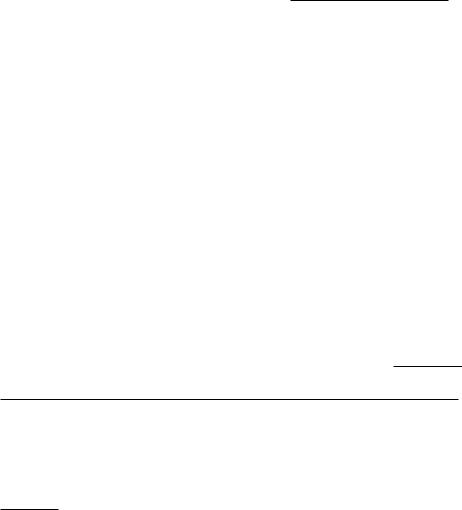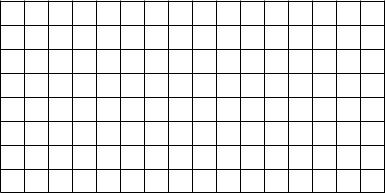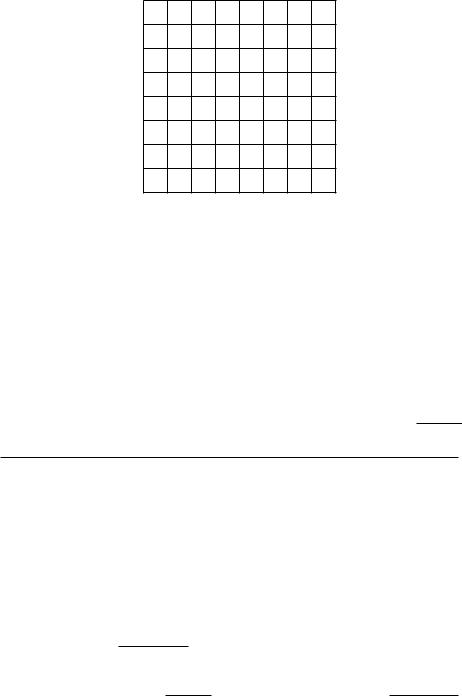
Varian Microeconomics Workout
.pdf
(c)Now let the price of hollyhocks fall to $3 a unit, while the price of delphiniums does not change. Draw her new budget line in black ink. Draw the highest indi®erence curve that she can now reach with red ink. Label the point she chooses now as B.
(d)How much would Maude's income have to be after the price of hollyhocks fell, so that she could just exactly a®ord her old commodity bundle
A? |
|
. |
(e) When the price of hollyhocks fell to $3, what part of the change in Maude's demand was due to the income e®ect and what part was due to
the substitution e®ect? |
|
. |
8.5 (1) Suppose that two goods are perfect complements. If the price of one good changes, what part of the change in demand is due to the
substitution e®ect, and what part is due to the income e®ect?
.
8.6 (0) Douglas Corn¯eld's demand function for good x is x(px; py; m) = 2m=5px. His income is $1,000, the price of x is $5, and the price of y is $20. If the price of x falls to $4, then his demand for x will change from
to |
|
. |
(a) If his income were to change at the same time so that he could exactly a®ord his old commodity bundle at px = 4 and py = 20, what would his
new income be? |
|
|
What would be his demand for x at this |
|||||||
|
|
|||||||||
new level of income, at prices px = 4 and py = 20? |
|
|
|
. |
||||||
|
|
|
||||||||
(b) The substitution e®ect is a change in demand from |
|
to |
||||||||
|
|
The income e®ect of the price change is a change in demand |
||||||||
from |
|
|
to |
|
|
|
|
. |
||
(c) On the axes below, use blue ink to draw Douglas Corn¯eld's budget line before the price change. Locate the bundle he chooses at these prices on your graph and label this point A. Use black ink to draw Douglas Corn¯eld's budget line after the price change. Label his consumption bundle after the change by B.

y
80
60
40
20
0 |
40 |
80 |
120 |
160 |
200 |
240 |
280 |
320 |
|
|
|
|
|
|
|
|
x |
(d) On the graph above, use black ink to draw a budget line with the new prices but with an income that just allows Douglas to buy his old bundle, A. Find the bundle that he would choose with this budget line and label this bundle C.
8.7 (1) Mr. Consumer allows himself to spend $100 per month on cigarettes and ice cream. Mr. C's preferences for cigarettes and ice cream are una®ected by the season of the year.
(a) In January, the price of cigarettes was $1 per pack, while ice cream cost $2 per pint. Faced with these prices, Mr. C bought 30 pints of ice cream and 40 packs of cigarettes. Draw Mr. C's January budget line with blue ink and label his January consumption bundle with the letter J.

Ice cream
100
90
80
70
60
50
40
30
20
10
0 |
10 |
20 |
30 |
40 |
50 |
60 |
70 |
80 |
90 |
100 |
|
|
|
|
|
|
|
|
|
Cigarettes |
|
(b) In February, Mr. C again had $100 to spend and ice cream still cost $2 per pint, but the price of cigarettes rose to $1.25 per pack. Mr. C consumed 30 pints of ice cream and 32 packs of cigarettes. Draw Mr. C's February budget line with red ink and mark his February bundle with the letter F . The substitution e®ect of this price change would make him buy
(less, more, the same amount of) |
|
cigarettes and (less, more, |
||
the same amount of) |
|
|
ice cream. Since this is true and the |
|
total change in his ice cream consumption was zero, it must be that the income e®ect of this price change on his consumption of ice cream makes
him buy (more, less, the same amount of) ice cream. The

income e®ect of this price change is like the e®ect of an (increase, decrease)
in his income. Therefore the information we have suggests
that ice cream is a(n) (normal, inferior, neutral) |
|
good. |
(c) In March, Mr. C again had $100 to spend. Ice cream was on sale for $1 per pint. Cigarette prices, meanwhile, increased to $1.50 per pack. Draw his March budget line with black ink. Is he better o® than in January,
worse o®, or can you not make such a comparison? How does your answer to the last question change if the price of cigarettes had
increased to $2 per pack? .
8.8 (1) This problem continues with the adventures of Mr. Consumer from the previous problem.
(a) In April, cigarette prices rose to $2 per pack and ice cream was still on sale for $1 per pint. Mr. Consumer bought 34 packs of cigarettes and 32 pints of ice cream. Draw his April budget line with pencil and label his April bundle with the letter A. Was he better o® or worse o® than in
January? |
|
|
Was he better o® or worse o® than in February, |
|
or can't one tell? |
|
|
. |
|
(b) In May, cigarettes stayed at $2 per pack and as the sale on ice cream ended, the price returned to $2 per pint. On the way to the store, however, Mr. C found $30 lying in the street. He then had $130 to spend on cigarettes and ice cream. Draw his May budget with a dashed line. Without knowing what he purchased, one can determine whether he is better o® than he was in at least one previous month. Which month or
months? |
|
. |
(c) In fact, Mr. C buys 40 packs of cigarettes and 25 pints of ice cream
in May. Does he satisfy WARP? |
|
. |
8.9 (2) In the last chapter, we studied a problem involving food prices and consumption in Sweden in 1850 and 1890.
(a) Potato consumption was the same in both years. Real income must have gone up between 1850 and 1890, since the amount of food staples purchased, as measured by either the Laspeyres or the Paasche quantity index, rose. The price of potatoes rose less rapidly than the price of either meat or milk, and at about the same rate as the price of grain °our. So real income went up and the price of potatoes went down relative to other goods. From this information, determine

whether potatoes were most likely a normal or an inferior good. Ex-
plain your answer.
.
(b) Can one also tell from these data whether it is likely that potatoes were
a Gi®en good?
.
8.10 (1) Agatha must travel on the Orient Express from Istanbul to Paris. The distance is 1,500 miles. A traveler can choose to make any fraction of the journey in a ¯rst-class carriage and travel the rest of the way in a second-class carriage. The price is 10 cents a mile for a secondclass carriage and 20 cents a mile for a ¯rst-class carriage. Agatha much prefers ¯rst-class to second-class travel, but because of a misadventure in an Istanbul bazaar, she has only $200 left with which to buy her tickets. Luckily, she still has her toothbrush and a suitcase full of cucumber sandwiches to eat on the way. Agatha plans to spend her entire $200 on her tickets for her trip. She will travel ¯rst class as much as she can a®ord to, but she must get all the way to Paris, and $200 is not enough money to get her all the way to Paris in ¯rst class.
(a) On the graph below, use red ink to show the locus of combinations of ¯rstand second-class tickets that Agatha can just a®ord to purchase with her $200. Use blue ink to show the locus of combinations of ¯rstand second-class tickets that are su±cient to carry her the entire distance from Istanbul to Paris. Locate the combination of ¯rstand second-class miles that Agatha will choose on your graph and label it A.

First-class miles
1600
1200
800
400
0400 800 1200 1600
Second-class miles
(b) Let m1 be the number of miles she travels by ¯rst-class coach and m2 be the number of miles she travels by second-class coach. Write down two equations that you can solve to ¯nd the number of miles she chooses to travel by ¯rst-class coach and the number of miles she chooses to travel
by second-class coach. |
|
. |
(c) The number of miles that she travels by second-class coach is
.
(d) Just before she was ready to buy her tickets, the price of second-class tickets fell to $.05 while the price of ¯rst-class tickets remained at $.20. On the graph that you drew above, use pencil to show the combinations of ¯rst-class and second-class tickets that she can a®ord with her $200 at these prices. On your graph, locate the combination of ¯rst-class and second-class tickets that she would now choose. (Remember, she is going to travel as much ¯rst-class as she can a®ord to and still make the 1,500 mile trip on $200.) Label this point B. How many miles does she travel by
second class now? (Hint: For an exact solution you will have to solve two linear equations in two unknowns.) Is second-class travel a
normal good for Agatha? Is it a Gi®en good for her? .
8.11 (0) We continue with the adventures of Agatha, from the previous problem. Just after the price change from $.10 per mile to $.05 per mile for second-class travel, and just before she had bought any tickets, Agatha misplaced her handbag. Although she kept most of her money in her sock, the money she lost was just enough so that at the new prices, she could

exactly a®ord the combination of ¯rstand second-class tickets that she would have purchased at the old prices. How much money did she lose?
On the graph you started in the previous problem, use black ink to draw the locus of combinations of ¯rstand second-class tickets that she can just a®ord after discovering her loss. Label the point that she chooses with a C. How many miles will she travel by second class
now? |
|
. |
(a) Finally, poor Agatha ¯nds her handbag again. How many miles will she travel by second class now (assuming she didn't buy any tickets before
she found her lost handbag)? |
|
When the price of second-class |
tickets fell from $.10 to $.05, how much of a change in Agatha's demand
for second-class tickets was due to a substitution e®ect? |
|
How |
||
much of a change was due to an income e®ect? |
|
|
. |
|

In previous chapters, we studied the behavior of consumers who start out without owning any goods, but who had some money with which to buy goods. In this chapter, the consumer has an initial endowment, which is the bundle of goods the consumer owns before any trades are made. A consumer can trade away from his initial endowment by selling one good and buying the other.
The techniques that you have already learned will serve you well here. To ¯nd out how much a consumer demands at given prices, you ¯nd his budget line and then ¯nd a point of tangency between his budget line and an indi®erence curve. To determine a budget line for a consumer who is trading from an initial endowment and who has no source of income other than his initial endowment, notice two things. First, the initial endowment must lie on the consumer's budget line. This is true because, no matter what the prices are, the consumer can always a®ord his initial endowment. Second, if the prices are p1 and p2, the slope of the budget line must be ¡p1=p2. This is true, since for every unit of good 1 the consumer gives up, he can get exactly p1=p2 units of good 2. Therefore if you know the prices and you know the consumer's initial endowment, then you can always write an equation for the consumer's budget line. After all, if you know one point on a line and you know its slope, you can either draw the line or write down its equation. Once you have the budget equation, you can ¯nd the bundle the consumer chooses, using the same methods you learned in Chapter 5.
A peasant consumes only rice and ¯sh. He grows some rice and some ¯sh, but not necessarily in the same proportion in which he wants to consume them. Suppose that if he makes no trades, he will have 20 units of rice and 5 units of ¯sh. The price of rice is 1 yuan per unit, and the price of ¯sh is 2 yuan per unit. The value of the peasant's endowment is (1 £ 20) + (2 £ 5) = 30. Therefore the peasant can consume any bundle (R; F ) such that (1 £ R) + (2 £ F ) = 30.
Perhaps the most interesting application of trading from an initial endowment is the theory of labor supply. To study labor supply, we consider the behavior of a consumer who is choosing between leisure and other goods. The only thing that is at all new or \tricky" is ¯nding the appropriate budget constraint for the problem at hand. To study labor supply, we think of the consumer as having an initial endowment of leisure, some of which he may trade away for goods.
In most applications we set the price of \other goods" at 1. The wage rate is the price of leisure. The role that is played by income in the ordinary consumer-good model is now played by \full income." A worker's full income is the income she would have if she chose to take no leisure.

Sherwin has 18 hours a day which he divides between labor and leisure. He can work as many hours a day as he wishes for a wage of $5 per hour. He also receives a pension that gives him $10 a day whether he works or not. The price of other goods is $1 per unit. If Sherwin makes no trades at all, he will have 18 hours of leisure and 10 units of other goods. Therefore Sherwin's initial endowment is 18 hours of leisure a day and $10 a day for other goods. Let R be the amount of leisure that he has per day, and let C be the number of dollars he has to spend per day on other goods. If his wage is $5 an hour, he can a®ord to consume bundle (R; C) if it costs no more per day than the value of his initial endowment. The value of his initial endowment (his full income) is $10 + ($5 £ 18) = $100 per day. Therefore Sherwin's budget equation is 5R + C = 100.
9.1 (0) Abishag Appleby owns 20 quinces and 5 kumquats. She has no income from any other source, but she can buy or sell either quinces or kumquats at their market prices. The price of kumquats is four times the price of quinces. There are no other commodities of interest.
(a) How many quinces could she have if she was willing to do without
kumquats? |
|
How many kumquats could she have if she was |
||||||||||||
willing to do without quinces? |
|
|
|
|
|
|
|
|
. |
|||||
|
Kumquats |
|
|
|
|
|
|
|
|
|
|
|||
|
40 |
|
|
|
|
|
|
|
|
|
|
|
|
|
|
|
|
|
|
|
|
|
|
|
|
|
|
||
|
30 |
|
|
|
|
|
|
|
|
|
|
|
|
|
|
|
|
|
|
|
|
|
|
|
|
|
|
||
|
|
|
|
|
|
|
|
|
|
|
|
|
||
|
20 |
|
|
|
|
|
|
|
|
|
|
|
|
|
|
|
|
|
|
|
|
|
|
|
|
|
|
||
|
|
|
|
|
|
|
|
|
|
|
|
|
||
|
10 |
|
|
|
|
|
|
|
|
|
|
|
|
|
|
|
|
|
|
|
|
|
|
|
|
|
|
||
|
|
|
|
|
|
|
|
|
|
|
|
|
||
|
|
|
|
|
|
|
|
|
|
|
|
|
||
|
|
|
|
|
|
|
|
|
|
|
|
|
||
|
0 |
|
|
10 |
20 |
30 |
40 |
|
||||||
|
|
|
|
|
|
|
|
|
|
|
Quinces |
|||
(b) Draw Abishag's budget set, using blue ink, and label the endowment bundle with the letter E. If the price of quinces is 1 and the
price of kumquats is 4, write Abishag's budget equation.
If the price of quinces is 2 and the price of kumquats is
8, write Abishag's budget equation. |
|
What e®ect does |
